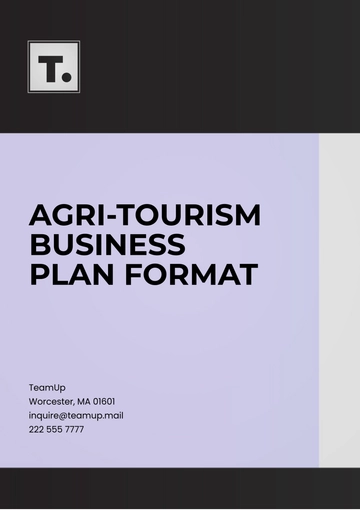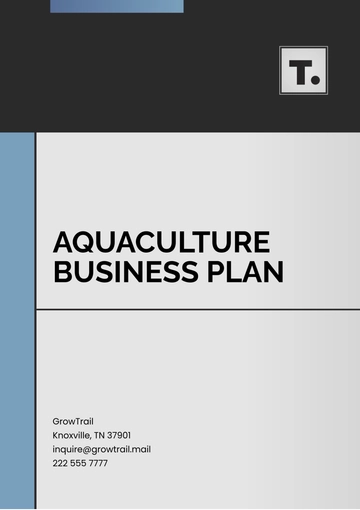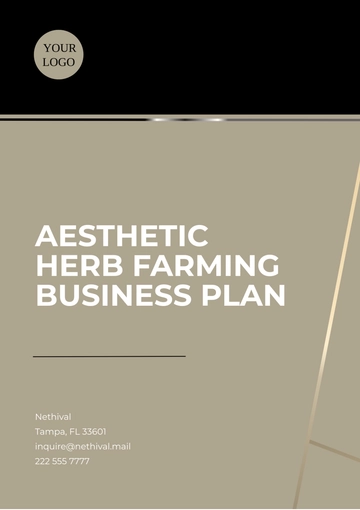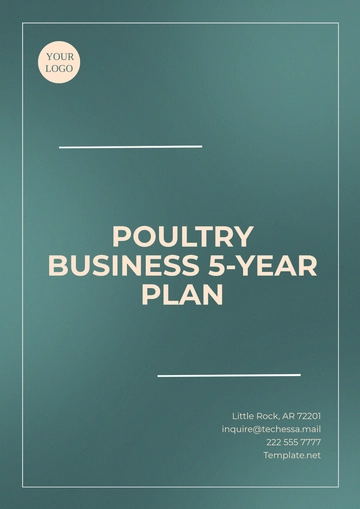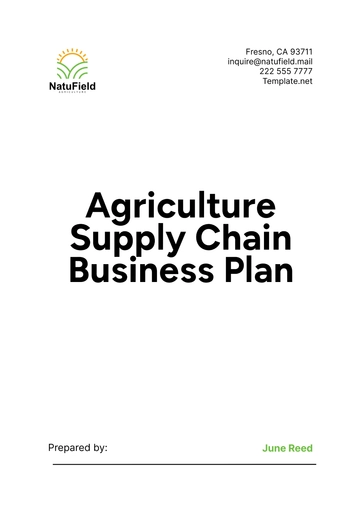Free Poultry Business 5-Year Plan

1. Executive Summary
Future Farms Poultry aims to become a leading supplier of sustainable, organic poultry products in the northeastern U.S. market. This 5-year business plan outlines our goals, strategies, and resources to achieve steady growth and long-term sustainability, targeting a 20% market share by 2065.
2. Mission and Vision Statements
Mission: To provide high-quality, sustainably raised poultry products that promote health and well-being for our customers and communities.
Vision: To be a trusted leader in the organic poultry industry, committed to environmental stewardship, animal welfare, and innovative farming practices.
3. SWOT Analysis
Strengths: Established customer base, sustainable farming practices, strong supplier relationships.
Weaknesses: Limited production capacity, and reliance on a single processing facility.
Opportunities: Growing demand for organic and local products, potential for export markets.
Threats: Rising feed costs, increased regulatory oversight, and market competition.
4. Goals and Objectives (2060–2065)
Sales Growth: Achieve a 15% annual growth in revenue, reaching $15 million by 2065.
Market Expansion: Establish a presence in three additional states by 2063.
Sustainability Goals: Reduce water usage by 25% and achieve a carbon-neutral status by 2065.
Customer Satisfaction: Maintain a 95% customer satisfaction rate across all product lines.
5. Key Strategies and Initiatives
Product Diversification: Introduce new product lines, including pre-packaged meals and organic eggs by 2061.
Market Penetration: Focus on expanding distribution to health-focused grocery stores and farmer's markets.
Sustainability Initiatives: Implement solar energy and rainwater harvesting systems at all farms by 2062.
Brand Development: Increase brand awareness through digital marketing, targeting eco-conscious consumers.
6. Resource Allocation and Budget (2060–2065)
Resource | Allocation | Budget ($M) |
|---|---|---|
Facility Upgrades | 20% | 2.5 |
Marketing and Brand Promotion | 15% | 1.8 |
Research & Development | 10% | 1.2 |
New Equipment and Vehicles | 25% | 3.0 |
Staff Training | 10% | 1.2 |
Sustainability Projects | 20% | 2.5 |
Total Budget | 100% | 12.2 |
7. Timeline and Milestones
2060: Launch new branding and website; complete initial market research.
2061: Roll out new product lines; expand distribution to two additional states.
2062: Achieve a 10% reduction in water and energy use; implement solar power on two farms.
2063: Enter three new markets; establish strategic partnerships with eco-friendly suppliers.
2065: Reach 20% market share in the northeastern U.S.; achieve carbon-neutral operations.
8. Risk Assessment and Contingency Plans
Risk: Volatile feed prices
Contingency: Establish long-term contracts with local suppliers, and explore alternative feed options.
Risk: Disease outbreak in poultry stocks
Contingency: Implement biosecurity protocols and establish an emergency fund for veterinary care.
Risk: Regulatory changes impacting organic labeling
Contingency: Regularly review compliance guidelines and maintain an active relationship with regulatory bodies.
9. Evaluation and Key Performance Indicators (KPIs)
Revenue Growth: Target a 15% annual growth rate.
Customer Satisfaction: Maintain at least a 95% satisfaction rate.
Environmental Metrics: Track water and energy usage, aiming for a 25% reduction by 2065.
Employee Retention Rate: Keep a retention rate of 90% or higher to sustain knowledge and skills.
10. Review and Adaptation Process
Annual reviews will assess progress on KPIs, budget alignment, and market conditions. Adjustments to strategies will be made as needed to ensure alignment with financial and sustainability goals. Regular check-ins with stakeholders and industry advisors will support continuous improvement.
- 100% Customizable, free editor
- Access 1 Million+ Templates, photo’s & graphics
- Download or share as a template
- Click and replace photos, graphics, text, backgrounds
- Resize, crop, AI write & more
- Access advanced editor
Take your poultry business to the next level with Template.net’s 5-Year Plan Template. This editable and customizable template is designed to help you plan for sustainable growth. Tailor it to fit your unique needs and objectives, and conveniently edit it in our Ai Editor Tool to ensure a streamlined and effective planning process.
You may also like
- One Page Business Plan
- Coffee Shop Business Plan
- Restaurant Business Plan
- Food Business Plan
- Real Estate Business Plan
- Executive Summary Business Plan
- Cover Page Business Plan
- Nonprofit Business Plan
- Daycare Business Plan
- Construction Business Plan
- Startup Business Plan
- Medical Business Plan
- Bakery Business Plan
- Service Plan
- Hotel Business Plan
- Catering Business Plan
- School Business Plan
- Healthcare Business Plan
- Transportation Plan
- Sports Plan
- Car Wash Business Plan
- Salon Business Plan
- Clothing Business Plan
- Farming Business Plan
- Boutique Plan










